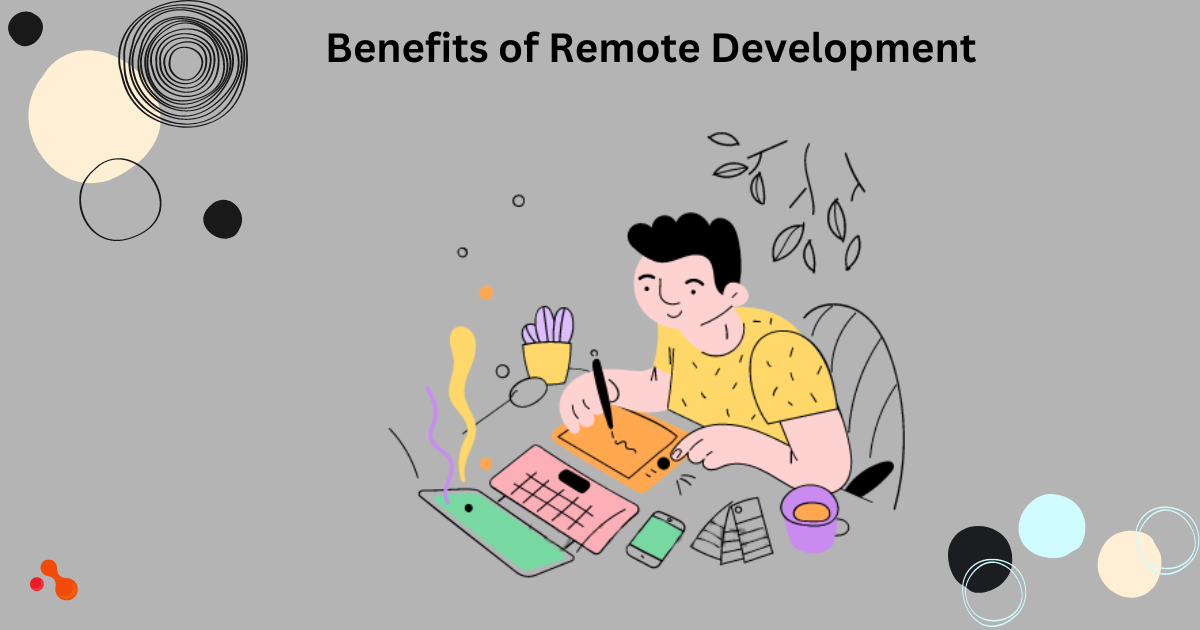Introduction
Imagine running a business and hiring developers worldwide without being physically present in your office. That's the power of remote development! It's a modern approach where talented developers work from their locations, collaborating online to create amazing software. But how do we ensure they work productively? That's where creating a conducive environment becomes crucial. Like a well-designed workspace boosts productivity, a remote developer needs a supportive setup too. We'll explore how to make it happen and discuss why it matters. So, if you're looking to hire remote developers and make the most of their skills, you're in the right place!
Benefits of Remote Development
Remote development, which involves hiring developers from different locations, offers numerous advantages, making it an appealing choice for businesses. Let's explore some of these benefits in a concise and easy-to-understand manner:

Flexibility:
- Remote development allows developers to work from anywhere, whether at home, in a coffee shop, or even in a different country.
- Developers are free to choose their working hours, which can increase productivity and satisfaction.
- Flexibility enables businesses to operate across different time zones and deliver projects faster.
Cost Savings:
- Hiring remote developers can be cost-effective for businesses as they eliminate expenses associated with providing physical office space, equipment, and utilities.
- Remote developers often work as independent contractors, so businesses can avoid costs like health insurance, taxes, and other benefits typically associated with full-time employees.
- Businesses can access global talent at competitive rates, as the cost of living and wage expectations vary across regions and countries.
Access to a Global Talent Pool:
- Remote development opens up opportunities to tap into a diverse talent pool worldwide.
- Businesses can hire developers with specialized skills and expertise that may be challenging to find locally.
- Access to a global talent pool allows companies to bring fresh perspectives and innovative ideas to their projects.
Growing Popularity and Impact:
- Remote development has gained immense popularity recently, transforming the software development industry.
- Many successful tech companies have embraced remote work and have built distributed teams to stay competitive and attract top talent.
- Remote development has revolutionized collaboration tools and technologies, making it easier for developers to work together seamlessly, regardless of their physical location.
To illustrate these benefits, consider an example: Imagine a small software startup based in a rural area. Hiring remote developers allows this company to access top-notch talent from major cities or even different countries. This provides the business with a broader skillset and reduces costs significantly compared to establishing a physical office in an expensive urban location.
In conclusion, remote development offers flexibility, cost savings, and access to a global talent pool, making it an increasingly popular choice in the software development industry. Embracing remote work opens new business possibilities and allows them to thrive in a dynamic and interconnected world.
Key Factors for Creating a Productive Environment

A. Communication and Collaboration:
- Communication is vital for a productive environment. It involves sharing information, ideas, and feedback effectively.
- Examples:
- Team meetings where everyone can discuss their progress and challenges.
- Using chat apps or video conferencing tools to connect with remote team members.
- Collaboration is about working together as a team to achieve common goals.
- Examples:
- Dividing tasks among team members and encouraging them to support and help each other.
- Using project management tools to track progress and ensure everyone is on the same page.
B. Establishing Trust and Accountability:
- Trust is crucial for a productive environment. It creates a sense of reliability and allows team members to depend on each other.
- Examples:
- Encouraging open and honest communication, where team members feel comfortable sharing their opinions and concerns.
- Giving credit where it's due and recognizing team members' contributions.
- Accountability ensures everyone takes responsibility for their tasks and delivers on their commitments.
- Examples:
- Setting clear expectations and deadlines for each team member.
- Encouraging regular progress updates and providing constructive feedback when necessary.
C. Providing the Right Tools and Infrastructure:
- Having the right tools and infrastructure is essential for efficiency and effectiveness.
- Examples:
- Using project management software to organize tasks, deadlines, and priorities.
- Providing access to reliable internet connections and necessary hardware for remote team members.
- The availability of appropriate tools and resources can significantly impact productivity.
- Examples:
- Using collaboration platforms like Google Docs or Trello for real-time document editing and task management.
- Providing access to training and learning resources to enhance team members' skills.
D. Creating a Positive Work Culture:
- A positive work culture contributes to motivation, satisfaction, and overall productivity.
- Examples:
- Encouraging teamwork, cooperation, and celebrating achievements as a team.
- Promoting work-life balance and recognizing the importance of employee well-being.
- Recognizing and appreciating the efforts of team members can foster a positive work environment.
- Examples:
- Implementing employee recognition programs or shout-outs during team meetings.
- Organizing team-building activities or social events to boost morale and strengthen team relationships.
Focusing on these key factors can create a productive environment where team members feel valued, motivated, and empowered to contribute their best. Effective communication and collaboration, trust and accountability, the right tools and infrastructure, and a positive work culture are all essential elements that support productivity and foster a cohesive and successful team.
Best Practices for Managing Remote Developers
Managing a team of remote developers can be a rewarding experience. Here are some best practices to help you effectively manage and support your remote developers:

Set clear goals and expectations:
Communicate what you expect from your remote developers regarding project deliverables, deadlines, and quality standards. This helps them understand their responsibilities and stay focused. For example:
- Clearly define the tasks and objectives for each project.
- Provide a timeline with specific milestones and deadlines.
- Share examples of successful outcomes to help them visualize the expected results.
Provide regular feedback and support:
Remote developers benefit from regular feedback and guidance to improve their skills and performance. Here's how you can support them:
- Schedule regular check-ins to discuss progress and provide feedback.
- Recognize their achievements and acknowledge their hard work.
- Offer constructive criticism to help them grow professionally.
- Be available to answer questions and provide guidance when needed.
Promote work-life balance:
Encourage your remote developers to maintain a healthy work-life balance to prevent burnout and maintain productivity. Here are some ways to promote work-life balance:
- Encourage them to take breaks and set boundaries between work and personal life.
- Support flexible working hours to accommodate different time zones.
- Promote self-care activities like exercise or hobbies to help them recharge.
Remember, managing remote developers is not just about work-related matters. It's also about creating a supportive and inclusive work environment. Consider these additional tips:
- Foster a sense of belonging by organizing virtual team-building activities or informal chats.
- Provide opportunities for skill development, such as online courses or workshops.
- Encourage collaboration and knowledge sharing among team members through virtual platforms.
By implementing these best practices, you can build a positive and productive relationship with your remote developers, ensuring their success and contributing to the overall success of your projects.
Conclusion
In conclusion, creating a productive environment for remote developers is crucial for the success of businesses in today's digital world. By embracing remote development and implementing effective strategies, companies can unlock a wealth of talent and reap numerous benefits. For instance, hiring remote developers allows businesses to tap into a global pool of skilled professionals, bringing diverse perspectives and innovative ideas. Businesses can empower remote developers to collaborate seamlessly and deliver outstanding results by providing the right tools and fostering clear communication channels. So, whether you hire developers locally or opt for remote talent, creating an environment that values productivity and supports remote work is key to thriving in the digital age.


Comments (1)